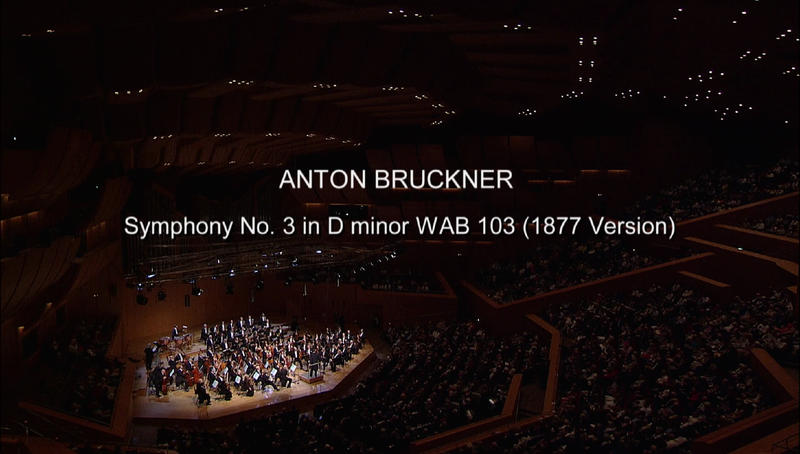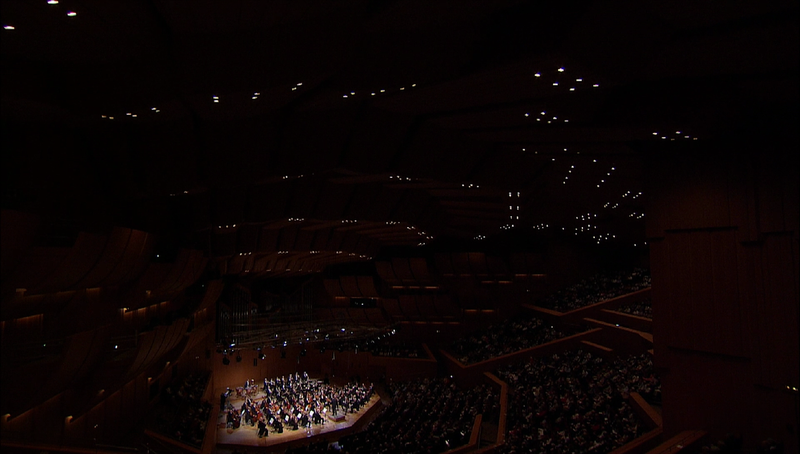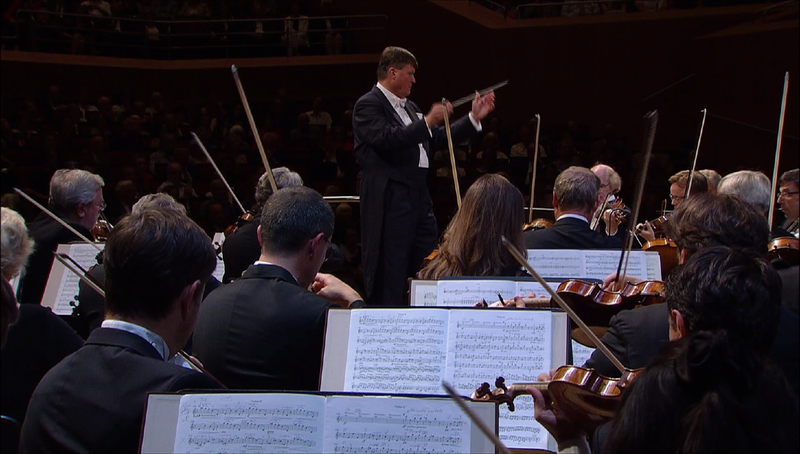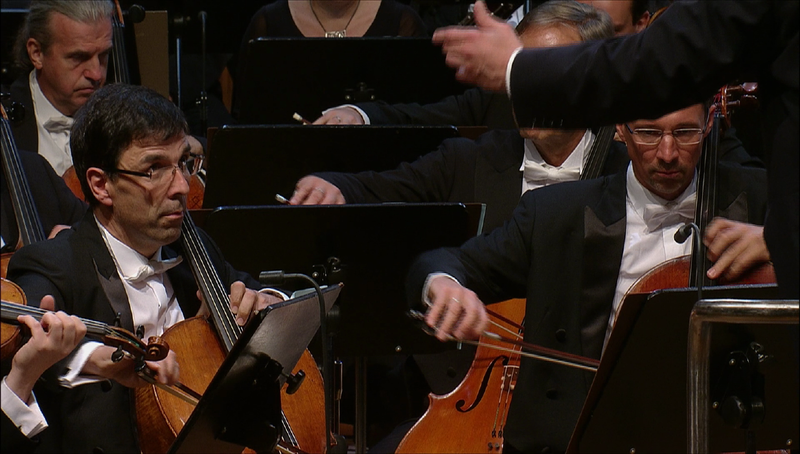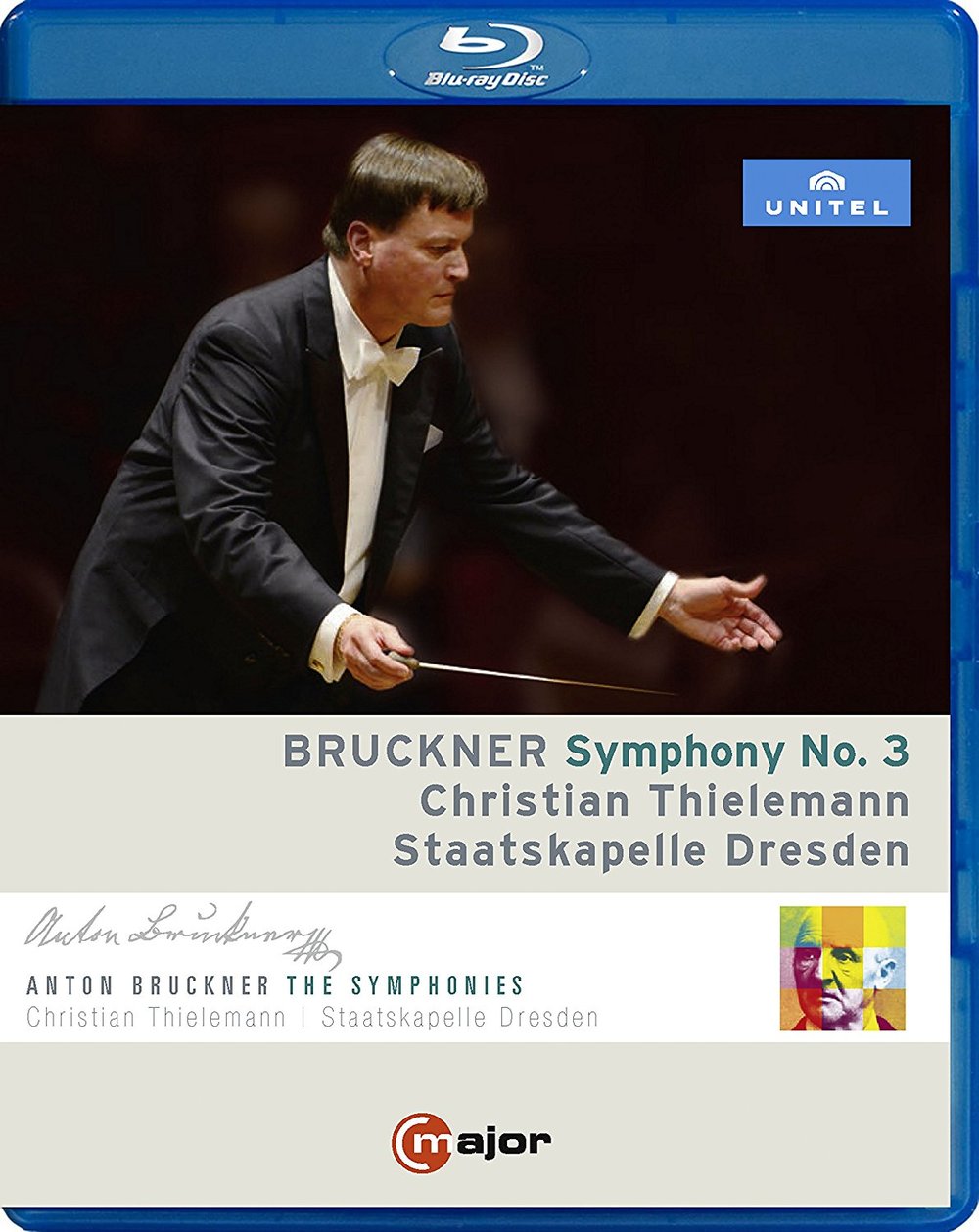
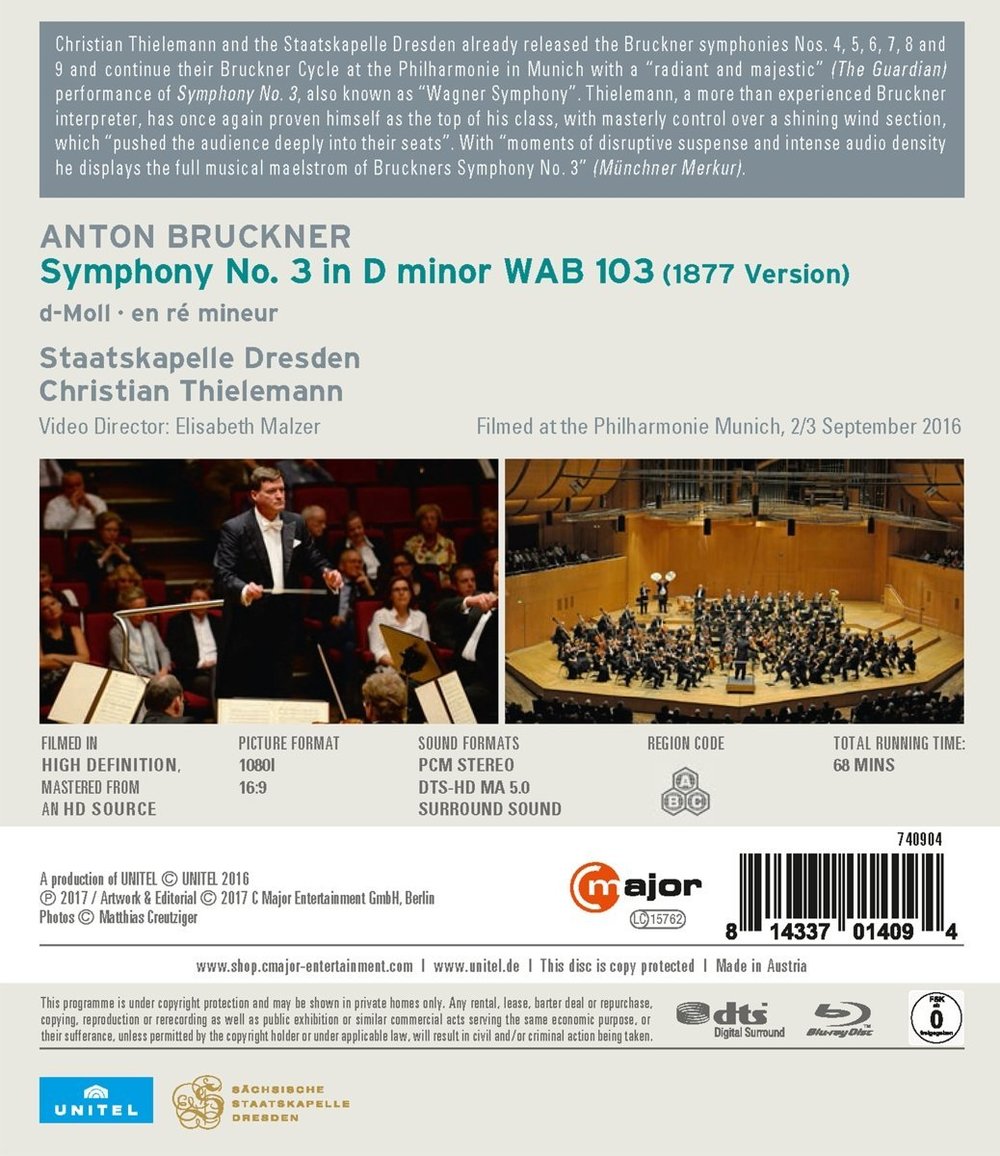
Bruckner Symphony No. 3 (the "Wagner Symphony"). Christian Thielemann conducts the Dresden Staatskapelle at the Philharmonie Munich in 2016. Directed for TV by Elizabeth Malzer. Released 2017, disc has 5.0 dts-HD Master Audio sound output. Grade: F+
Christian Hoskins in the August 2017 Gramophone (page 34) lauds this recording for grandeur with orchestra playing in a "class of its own." He states this title is one of the best recordings of the Bruckner S3 "available in any medium." Later in the December 2017 Gramophone, page 36, Hoskins calls this his favorite recording for 2017! With this kind applause from Hoskins, we can assume subject title is an excellent sound recording of a splendid performance. And as you can see from the screenshots below, the PQ is also satisfying with nice lighting, good color balance, and decent HD resolution.
Hoskins also mentions the video content stating that "Elizabeth Malzer's video direction is relatively unimaginative, which is not necessarily a bad thing." So we put this title on the buy list promptly in hopes that Malzer might be slowing down the pace and making big-scale shots in an effort to avoid the problem of DVDitis that is so prevalent in Blu-ray symphony recordings.
But it's so distressing: we have to report that the video content in this Bruckner 3 is the worst we have seen ever from a major publisher with a video originally shot in 1080i or better (the absolute worst was the Avie Mahler 10 which must be regarded as probably student work). Having reached and breached this sad conclusion, we have to offer plenty of proof. Here goes.
The first solemn obligation of the videographer of a symphony concert is to give the home viewer whole-orchestra (WO) shots at the outset so that the viewer can see how the orchestra is organized and where the players are located. The viewer needs this info to understand what he's seeing in the smaller-scale clips he will encounter throughout the recording. And this is especially true when, as here, the layout of the orchestra is a bit unusual.
Well, next below is a screenshot of Malzer's opening clip as the title of the disc appears. But this is not a WO view, because the players on the stage are so tiny. You can see the tympani and a cluster of basses, which you can't reliably count. Otherwise you can't tell who is where. In a WO shot, the players must fill the entire field of vision horizontally across the film to show the viewer as much as possible about the musicians:
So Malzer has split her britches badly before the music begins. Instead of a WO shot, she gives us an "anthill." (There are times when the videographer might add value with this kind of shot to show us a magnificent concert hall, but that doesn't apply here when the lights are already down.) To make matters worse, Malzer seems to be positively enamoured of mounds Formicidae, which she sprinkles 30 times throughout the video. Next below we show 2 of her anthilliest views, which often pop up when Bruckner reaches one of his volcanic eruptions of fffff sound.
But the most irritating thing of all about this perverse mismatch of big sounds with tiny pictures is that Malzer had a splendid WO shot in her quiver that she could have used at will. That's the next shot below which appears exactly one time in the video, and that at 46:04, which is about 3/4s of the way through the symphony:
For most of the video, we were lost in space watching small-scale views of solos or small groups and constantly wondering where they were sitting on the stage. But at 46:04 we hit the freeze-frame button to finally study the lay of the land. We learned there are some 16 1st violins, 14 2nd violins, 12 violas, 10 cellos in a ragged wedge, and probably 12 basses. It appears there are 4 trumpets, 3 bones, 4 horns, and 2 each of the rest of the standard winds, plus one set of tympani. The woodwinds appears to be seated quite far apart. The rest of the players are a bit crowded together. This information makes it so much easier to understand the rest of the remaining clips in the film. Watching a symphony video shouldn't have to be like solving Rubik's Cube!
Astonishingly, this WO shot (46:04), which is the best image in the entire disc, only appears one time in the video. And it lasts for less than 3 seconds! How is is possible to for Malzer to do everything so upside-down and backwards!
Next below we see one other WO shot, which occurs a single time at 51:04. It misses players on the left, but we are usually happy if the WO angle picks up 90%+ of the players. It's quite lop-sided. But the main problem with this WO shot is that the angle is too low. The players on the front and the music stands hamper our view of the interior of the orchestra:
We count the part-orchestra (PO) view below about 13 times in the video. Once again, it's lop-sided, and it would be nice if the angle were higher to give us a better view:
A chief hallmark of a good symphony Blu-ray is the use of many large-scale shots throughout. So far we have only counted 15 WO and PO shots. So next we observe there are 56 other large-scale images of sections and groups of sections. But 41 of those 56 large-scale shots are slight variations of the same image, which we call the "brass row." That's right, about 9% of the video clips show the 4 trumpets and 3 trombones seen below:
And most of the other 15 large-scale shots in this video have something to do with the bass section:
At this point we have covered the meager large-scale views in this film. What else is there to see? Well, there are 86 shots of Thielemann from a few feet away (the conductor or "C" shots):
And there are another 24 shots of Thielemann made over the backs of musicians (C/B):
The bulk of the rest of the video are small-scale shots of 1 to 4 musicians. Some of them are close-ups of one or two players like the next two views below:
And here we see pieces of 4 players surrounding the principle oboe player in the center:
And here next is a shot of the same group as above, but from the other side. We did a special count and can report that the principle oboe appears in no fewer than 59 images. It gets really boring to see the same player in 12.5% of the clips in a video:
This was intended to be a shot of the horn section. We call it a "music stand shot." As here, most of the cameras seem to be posted too low to get good views of the musicians. The cameras are too often even shooting up at their subjects:
Another music stand shot:
Next are two clips of 2nd violins and violas from the wrong angle. You can't see the strings and the fingering:
There are quite a few shots of the violas and 2nd violins, but not a single good shot of the 1st violins:
Now the camera on the right side of the orchestra (that shot so many clips of the principal oboe) turns slightly the right to get a strange view of the horns from below:
Now a camera rakes across violas and 2nd violins in a weird image marred by violent foreshortening from the camera lens. The lady with the long red hair is the 2nd violin sitting on the edge of the stage 4 seats away from the conductor. Study and compare this image to the 1st WO above to grasp how wildly distorted this is. But at least the angle is good:
The next 4 screenshots below represent many images in the video with framing errors:
Below is one of about 7 or 8 shots probably made from the rear on an old SD camera mixed in with the HD gear. Or maybe there was a camera just out-of-focus. This should have been edited out:
We get all the numbers above by running a Wonk Worksheet on the video:
There are 61 minutes, 10 seconds of music divided into 473 video clips. This yields the (too rapid) pace of 7.8 seconds per clip.
Here's the clip breakdown:
Conductor shots = 86
Conductor-over-backs shots = 24
Solo and other small-scale clips = 247
*Large-scale clips = 56
*Part-orchestra clips = 13
*Whole-orchestra clips = 2
Instrument-only clips = 13
Other low-value shots = 32 (mostly the anthills)
There are 71 "supershots" (add up the * numbers above of 56+13+2). So the supershots are 15% of the total clips (71/473). Conductor shots total 110 (86+24), and conductor shots use up 23% of the clips (110/473).
We have established the following rules-of-thumb to identify a Blu-ray with DVDitis:
A good symphony HDVD should have a slow pace with more than 10 seconds per video clip on average. 20 to 40% of the clips should be large-scale "supershots." Conductor shots should be less (way less really) than 20% of the clips in the video.
Subject title fails the pace test with the average clip running only 7.8 seconds. It flunks the conductor test at 23%. And it also flunks the most important test, the supershot test, with a score of only 15%. This is the ugly face of virulent DVDitis. And there are additional demerits for too many instrument-only (IO) shots, lack of orientation images, extreme repetitiveness in framing, many frame composition errors, bad angles, excessive panning and zooming, cameras posted too low, bad lighting throwing shadows on the faces of musicians, too many shots "down the line" with musicians blocking out the view of neighbors, and the infuriating failure to use effectively the wonderful WO shot at 46:04.
Now for a grade. We start with A+. We reduce the grade to A for lack of 96kHz/24-bit sound. PQ is fine. The performance and sound recording are accepted as excellent per Christian Hoskins' Gramophone review. But this title flunks all of the video content tests. So we reduce the grade from A to D. Heaping all the other smaller deficiencies onto the scale knocks this title down deep into F territory. Somehow this whole thing smells of industrial sabotage. It's truly distressing to see that a video this bad was made late in 2016 after the industry has been working on these projects for almost a decade. Still, we have to somehow give this title a bit of recognition for performance quality in the face of the disastrous failure of video content. OK, let the grade be F+.
PS: This is not a generous program with one hour of music on a disc that can hold 4 hours. All the pictures of Thielemann on the keepcase package and the booklet are stock photos showing the conductor as a fitter man than he was in 2016. He's reached the point now where conducting Bruckner for an hour puts a real strain on him. And the orchestra in the package artwork is not playing Bruckner's Symphony No. 3, which is not scored with a tuba, cymbals, or triangle. G'rrrr.
OR
